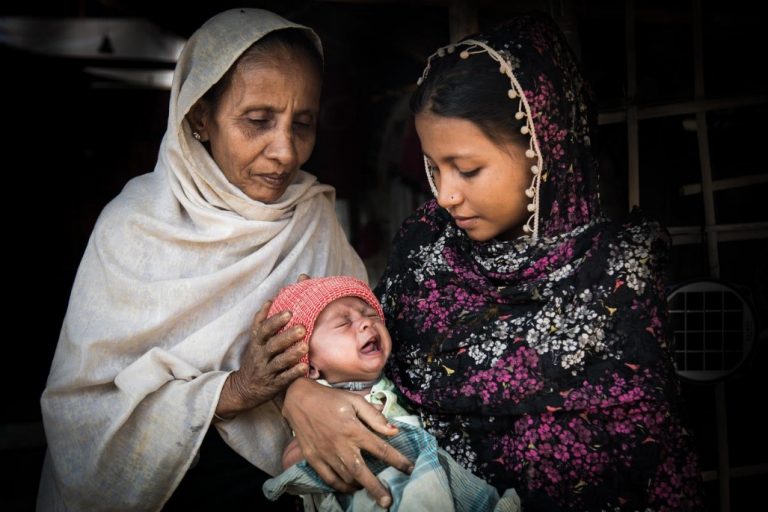Since 2017, hundreds of thousands of Rohingya have escaped the systematic violence and oppression they faced in Myanmar in hopes of securing a safer and healthier life for their children. In Cox’s Bazar, a new mother, Azida, recalled her treacherous journey with her family while eight months pregnant. “We fled when the village to the east of us was burnt down. It took 15 days […] My mother held my hand. My husband lifted me when I fell […] I got a fever and I could not eat. I didn’t want to walk anymore. We spent five days at the border, waiting to cross.”
Once in Bangladesh, Azida gave birth to her son, Ismil, at home – a makeshift hut: “My mother cut the [umbilical] cord with a blade boiled in hot water and tied it with thread we had bought. I did not know what was happening.” Dangerous, disrespectful and negative personal experiences with receiving healthcare in Rakhine State, Myanmar, has left many pregnant women in Cox’s Bazar hesitant to seek safe antenatal and delivery care from facilities. Whether births are taking place at home or in medical facilities, they have not been registered by Bangladesh through an official process since the influx of nearly 700,000 Rohingya.
Registration not only establishes legal identity, but it also authorizes access to basic rights such as medical care, education, food, and other social services. It is a tool used by humanitarian organizations to identify infants and provide adequate assistance in a timely manner, especially during the critical first week of life.
Counting every birth ensures that funding and resources are sufficiently allocated, helping drive policy and program implementation to improve overall newborn health.
International standards, including the Newborn Health in Humanitarian Settings: Field Guide, highlight birth registration as an essential part of newborn care during the immediate postnatal period. Despite this, Bangladesh’s policy has restricted health providers caring for Rohingya newborns, lowering the quality and completeness of newborn care that they are able to offer. Without documentation, refugees are discouraged from accessing public healthcare, constraining them to a small set of health facilities inside crowded camps with insufficient emergency services.
While it is imperative to establish prompt referral pathways for maternal and newborn complications, patients may face many hurdles such as treatment cost, transportation, and military checkpoints. Even in situations where both mother and child are successfully referred outside the camps, they may be overlooked and deprioritized as stateless persons, having detrimental effects on time-sensitive emergency cases.
Established recordkeeping also helps define and explain important health indicators in the community. Nevertheless, the absent registration systems have affected humanitarian organizations’ attempts to measure birth and mortality rates among the Rohingya. Without proper estimates for the number of live births, both the maternal mortality ratio (MMR) and the newborn mortality rate (NMR) reliability is hindered. Therefore, it can challenging to address the inequalities that exist in accessing services and to increase the accountability of stakeholders to strengthen the health system.
Bangladesh has openly accepted and accommodated over a million Rohingya in their country. Yet, by restricting birth certificates and identification cards, this situation is heightening their vulnerability. A strong commitment to universal birth registration in the Rohingya camps will be key to help ensure that babies like Ismil can enjoy an equitable and empowered future.
